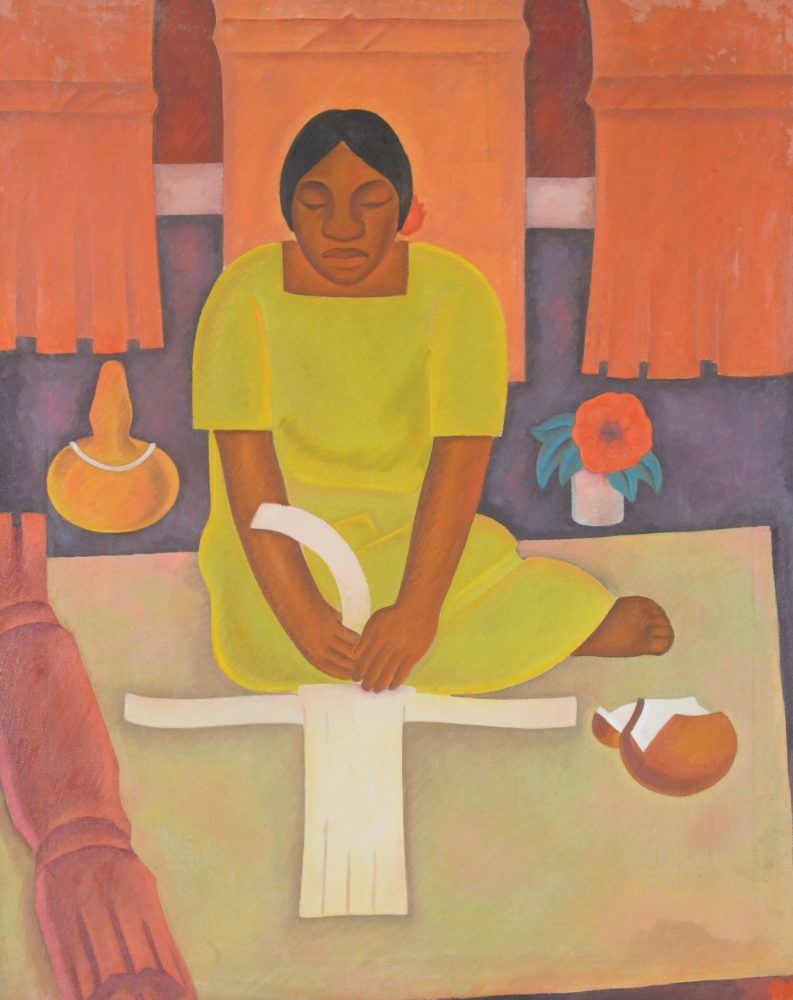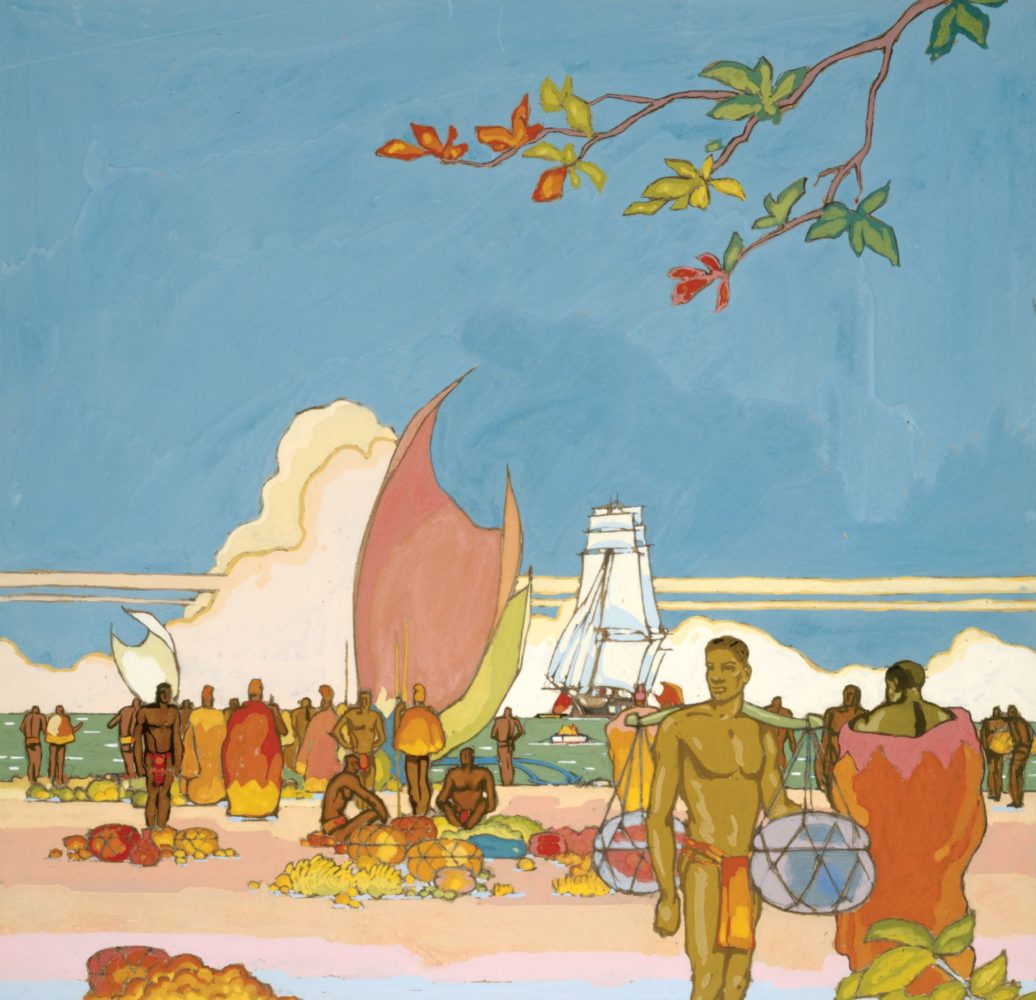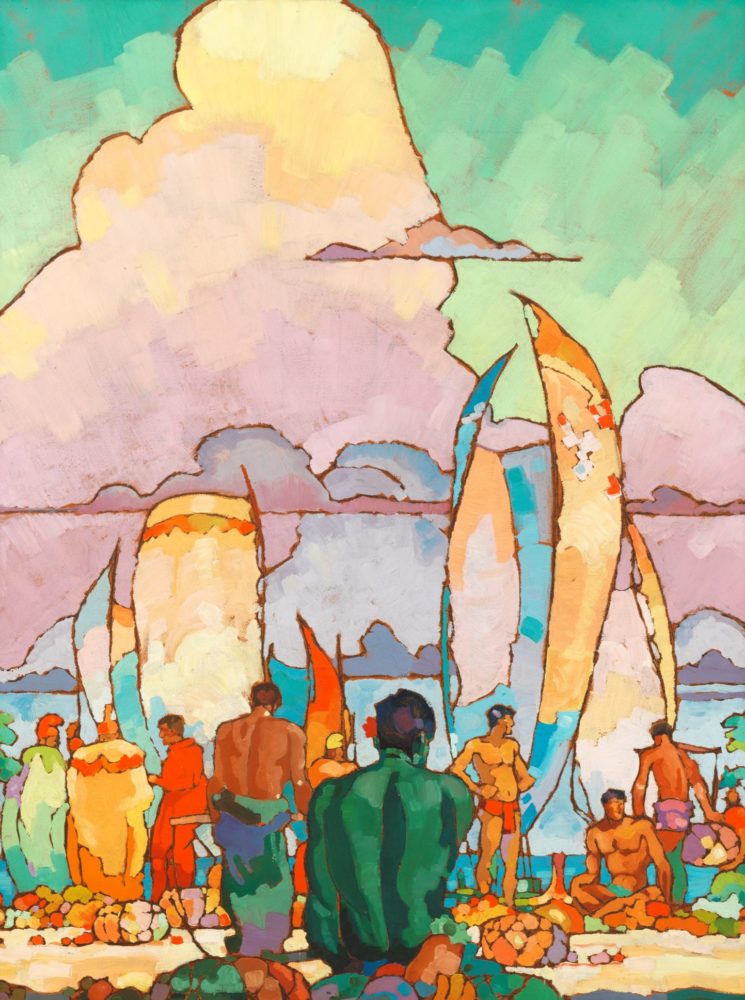The modernist Armenian painter Arman Manookian lived a short and mysterious life. He left a legacy that defies definition yet demands continued interpretation.
At the time, the untitled 1930 oil on canvas work, later dubbed “The Mat Weaver,” represented a new direction for artist Arman Tateos Manookian. Its hint of pastel, softer lines, and humanist composition were subtle departures from the bold colors and crisp geometry of his previous works such as “Outrigger and Red Sails,” which portrayed reverent visions of “Old Hawai‘i” as an untouched culture of near mythological beings.
The Turkish-born artist had arrived at Pearl Harbor in 1925 as a 21-year-old clerk for Major Edwin McLellan, a Marine historian who had noticed Manookian’s talent for illustration when he was assigned to his office and tasked the artist with creating drawings to accompany his historical publications. (Manookian’s work also regularly appeared in the Marine Corps magazine Leatherneck.)
Manookian had enlisted in the Marines in 1923, after two years of art study at the Rhode Island School of Design. He falsified his U.S. Citizenship to do so; he’d landed at Ellis Island three years prior as a refugee, having fled the Armenian genocide that began in Constantinople in 1915 when he was 10 years old.
After being discharged from the military in 1927, Manookian remained in Honolulu and began to flourish as a painter, his dazzling work quickly gaining public and critical acclaim.
A brilliant colorist, he deployed a simplified yet somehow harmonized palette of electric reds and blues and radiant golds and relied on abstraction for conveying emotion. In a newspaper article, he was quoted as saying, “certain arrangements of abstract forms and colors, quite independent of objective nature, are capable of producing a sensation much more pleasing, satisfying, lasting and profound than any representative painting will ever achieve.”
You May Also Like: The Allure of Georgia O’Keeffe’s Hawai‘i Paintings

At the same time, according to David W. Forbes in his book Encounters with Paradise: Views of Hawai‘i and Its People, 1778-1941, Manookian “rejected attempts to label his work as ‘modern.’” This contradiction was perhaps symptomatic of a deeper internal conflict.
Argumentative, temperamental, enigmatic even to those close to him, Manookian was known to have destroyed his work on more than one occasion. He clearly struggled to understand both his personal and professional place in the world.
No one knows what horrors Manookian witnessed as a boy, but art historian John Seed, who is the primary authority on Manookian, has suggested it’s conceivable that his arrival in Hawai‘i inspired him to express a utopian vision of life his own people never had the chance to pursue.
While modernism at the turn of the century centered on a rejection of history and a belief in progress, Manookian looked to the past for his utopia, in which an unassuming society lives out an idyllic communion with nature.

Idyllic, and marketable. Before “The Mat Weaver,” Manookian’s pieces more heavily displayed motifs—relative simplicity, planarity, recursion—associated with the art deco movement, which coincided with the Hawai‘i Promotion Committee’s schemes to push the U.S. territory as a world-class travel destination.
Art deco has been described as modernism made accessible, and the HPC leveraged this style as the promotional aesthetic of Hawai‘i for the tourism industry for decades to come. Theresa Papanikolas, the curator of an Art Deco Hawai‘i exhibition at the Honolulu Museum of Art in 2014, which featured Manookian prominently, wrote, “artists like Manookian spun the islands’ oft-contested past as an innocent idyll peacefully populated by brave, seafaring men and lovely, accommodating women.”
While Manookian’s portrayals of Hawai‘i may have informed the narrative the HPC was eager to market, there are also clues to a subversive streak. In his 1928 work “The Discovery,” Manookian depicts the arrival of Captain Cook in Hawai‘i: In the foreground, with their backs to us, local chiefs look on, large and proud and rich in color, as the British land ashore as diminutive specters, grey and featureless, harbingers of impending and irrevocable change. Was Manookian making a political commentary here? If so, how does this reconcile with his escapist utopias? Perhaps this was more internal conflict.

It seems possible, then, that the new direction in “The Mat Weaver” was a response to these dissonances; that Manookian was attempting to embrace the modernism in his work he’d previously denied, and, by presenting a humbler figure going about an everyday task, was pivoting from historical fantasies to more contemporary, social concerns.
Whatever he was searching for in his art, it seems he was unable to find it. In 1931, Manookian took his own life. He was 27.
That his career was so short, and yet so seminal and enduring, means that we are compelled to continue to interpret it, even though, like Manookian, we may never find definitive answers.

